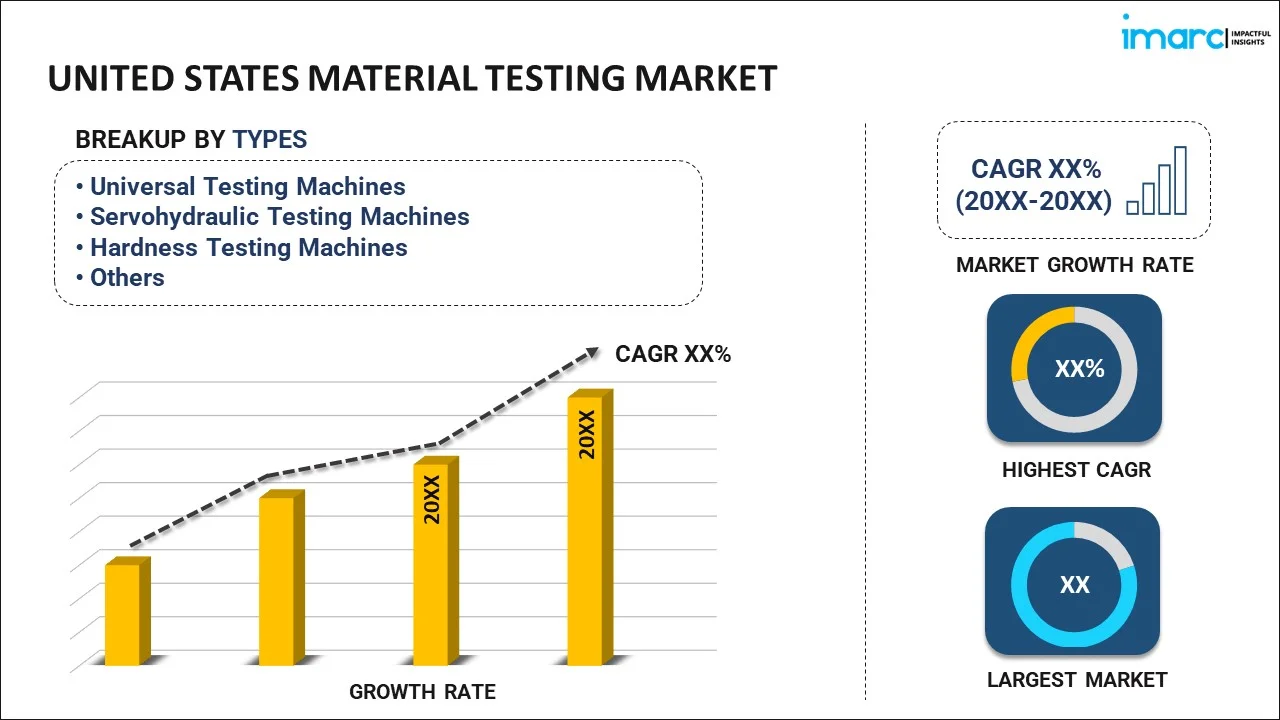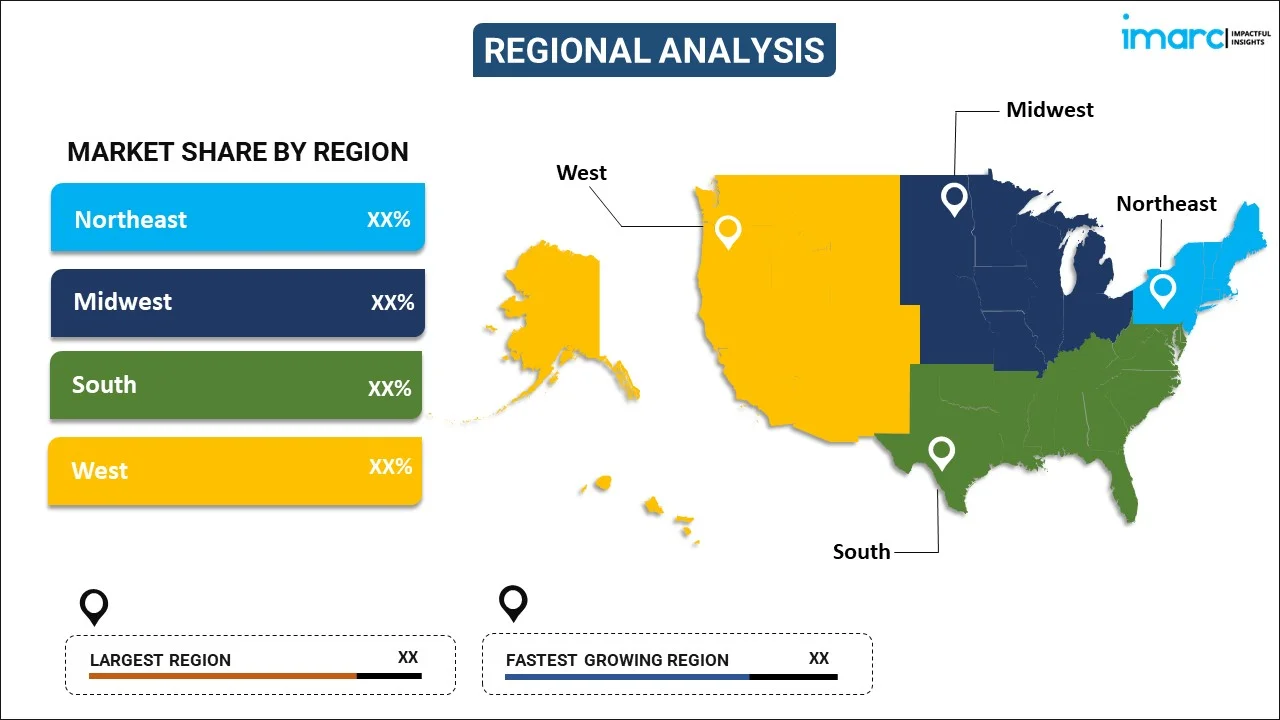
United States Material Testing Market Report by Type (Universal Testing Machines, Servohydraulic Testing Machines, Hardness Testing Machines, Impact Testing Machines, Non-Destructive Testing Machines), Material (Metals and Alloys, Plastics, Rubber and Elastomers, Ceramics and Composites, and Others), End Use Industry (Automotive, Construction, Education, Aerospace and Defense, Oil and Gas, Energy and Power, and Others), and Region 2025-2033
Market Overview:
The United States material testing market size reached USD 1,617.6 Million in 2024. Looking forward, IMARC Group expects the market to reach USD 2,039.7 Million by 2033, exhibiting a growth rate (CAGR) of 2.48% during 2025-2033.
|
Report Attribute
|
Key Statistics
|
|---|---|
|
Base Year
|
2024
|
|
Forecast Years
|
2025-2033
|
|
Historical Years
|
2019-2024
|
|
Market Size in 2024
|
USD 1,617.6 Million |
|
Market Forecast in 2033
|
USD 2,039.7 Million |
| Market Growth Rate (2025-2033) | 2.48% |
Material testing is a technique used to measure the physical and mechanical properties of different raw materials and components. It offers compression, elongation, ductility, and tensile, bond, bend, rupture and puncture strength. It also provides excellent toughness, and resistance against tear and crush. As a result, material testing is utilized in a diverse range of applications for analyzing the performance of plastics, metals, rubber, textiles, woods, electronics, ceramics, and building materials across the United States.
United States Material Testing Market Trends:
Considerable growth in the construction industry of the US represents one of the key factors positively influencing the utilization of material testing for improving the quality of the building materials. In addition, the technique is employed in the automotive industry to ensure material strength and improve performance. Moreover, due to the increasing complexity of aircraft, material testing finds extensive application in the defense and aerospace sector of the US to test mechanical properties and maintain the quality of products. Apart from this, extensive research and development activities, along with the rising need in the medical sector to test material integrity, surface morphology, and adhesion capacities, are creating a positive outlook for the market across the country.
Key Market Segmentation:
IMARC Group provides an analysis of the key trends in each segment of the United States material testing market report, along with forecasts at the country and regional levels from 2025-2033. Our report has categorized the market based on type, material and end use industry.
Breakup by Type:

- Universal Testing Machines
- Servohydraulic Testing Machines
- Hardness Testing Machines
- Impact Testing Machines
- Non-Destructive Testing Machines
Breakup by Material:
- Metals and Alloys
- Plastics
- Rubber and Elastomers
- Ceramics and Composites
- Others
Breakup by End Use Industry:
- Automotive
- Construction
- Education
- Aerospace and Defense
- Oil and Gas
- Energy and Power
- Others
Breakup by Region:

- Northeast
- Midwest
- South
- West
Competitive Landscape:
The competitive landscape of the industry has also been examined along with the profiles of the key players.
Report Coverage:
| Report Features | Details |
|---|---|
| Base Year of the Analysis | 2024 |
| Historical Period | 2019-2024 |
| Forecast Period | 2025-2033 |
| Units | Million USD |
| Segment Coverage | Type, Material, End Use Industry, Region |
| Region Covered | Northeast, Midwest, South, West |
| Customization Scope | 10% Free Customization |
| Post-Sale Analyst Support | 10-12 Weeks |
| Delivery Format | PDF and Excel through Email (We can also provide the editable version of the report in PPT/Word format on special request) |
Key Questions Answered in This Report:
- How has the United States material testing market performed so far and how will it perform in the coming years?
- What has been the impact of COVID-19 on the United States material testing market?
- What are the key regional markets?
- What is the breakup of the market based on the type?
- What is the breakup of the market based on the material?
- What is the breakup of the market based on the end use industry?
- What are the various stages in the value chain of the industry?
- What are the key driving factors and challenges in the industry?
- What is the structure of the United States material testing market and who are the key players?
- What is the degree of competition in the industry?
Need more help?
- Speak to our experienced analysts for insights on the current market scenarios.
- Include additional segments and countries to customize the report as per your requirement.
- Gain an unparalleled competitive advantage in your domain by understanding how to utilize the report and positively impacting your operations and revenue.
- For further assistance, please connect with our analysts.
 Inquire Before Buying
Inquire Before Buying
 Speak to an Analyst
Speak to an Analyst
 Request Brochure
Request Brochure
 Request Customization
Request Customization




.webp)




.webp)












